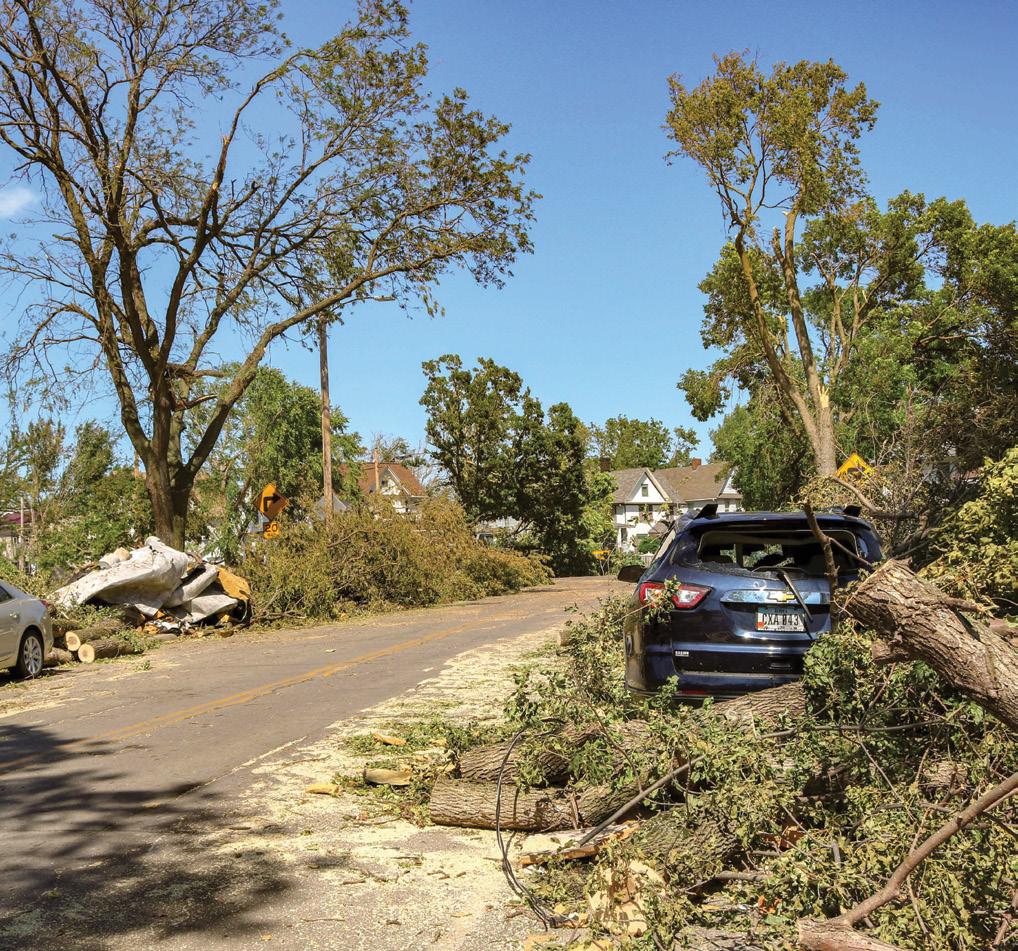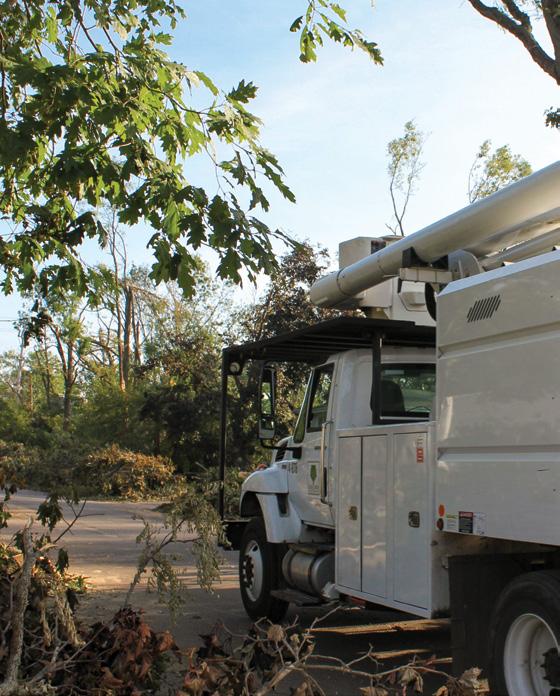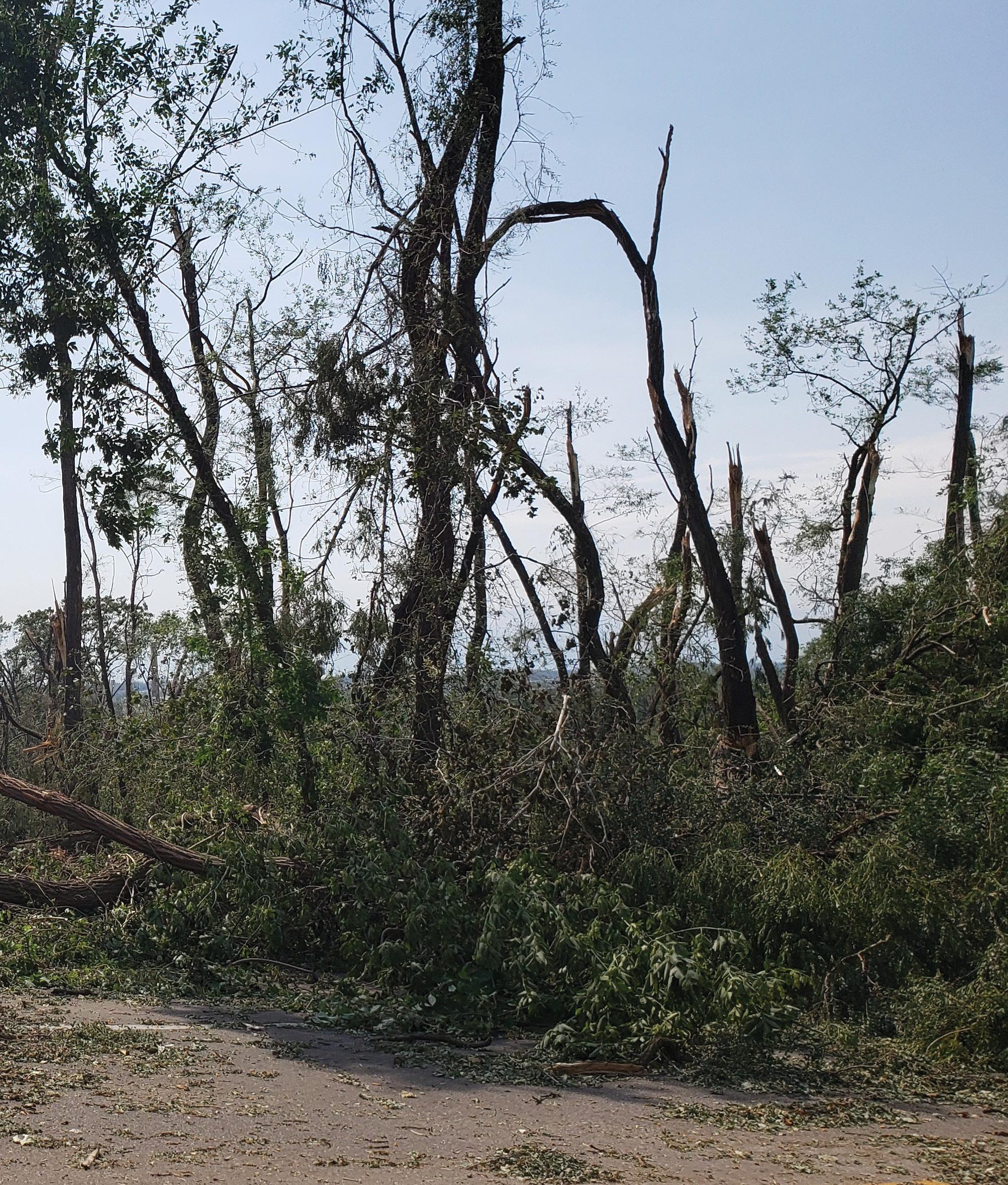
12 minute read
STORIES FROM THE FRONT LINES
First Responders and City Staff Share Their Accounts of the Disaster
HEIDI D’ARCY, Dispatcher II, Joint Communications Agency
A few minutes before an official warning is issued by the National Weather Service, dispatchers can hear the meteorologist preparing for the broadcast alert. “He sounded flustered and said to take shelter immediately. Three minutes before the derecho hit, we knew it was going to be serious,” Heidi D’Arcy recalls as she was working on the third floor of the Police Station in the City’s Joint Communications Agency.
It was a day like no other for D’Arcy, who has been a telecommunicator for over ten years. As the floor was vibrating and the windows were bowing, dispatchers remained calm and attempted to answer as many 911 calls as possible. At one time, over 250 fire calls were stacked up waiting for first responders to be dispatched.
D’Arcy’s first storm-related call was a semi-truck driver who was on U.S. Interstate 380 northbound near Diagonal Drive who was concerned for his safety as winds were increasing and wanted to know if he could get help locating a place to park. D’Arcy subsequently directed him to Valor Way SW, where he safely remained during the storm.
“One of my most memorable calls was a girl babysitting her little brother. They had gone to a storm shelter but the lock on the outside door broke because of the strong winds. I used our dispatch tornado protocol and instructed the children to grab pillows and blankets, and get into the bathtub in the interior of the home to stay safe. The young girl did such a good job with the directions, even though I knew they had to be really scared at home alone.”
It would not be until 12:30 a.m. the next day that fire and police calls were no longer stacked up waiting for first responders to be dispatched. D’Arcy said, “We did the best that we could given the situation.” She is proud of her coworkers, even recalling how one dispatcher rode a bike to get to work even though her own house was damaged by the derecho.
OFFICER TYLER RICHARDSON, Police Officer
Police officers were on patrol throughout the city at 12:30 p.m. on August 10 when the derecho impacted the community. Officer Tyler Richardson, a 10-year veteran of the Police Department, was in the 1600 block of Second Avenue SE when power lines and trees started to fall onto the roadway. “There were a lot of big trees in the area and I knew that I needed to get out of there before one fell on my car,” said Richardson.
As he drove onto First Avenue past Brucemore, Richardson saw that a tree had fallen onto a car near 20th Street. Despite winds over 100 miles per hour, torrential rainfall, and debris flying throughout the air, he exited his police vehicle to see if anyone needed assistance. He found a woman inside the car.
The driver’s side door wouldn’t open, but Richardson was able to open the passenger side door, which was partially blocked by a tree limb. Richardson recalled, “The air bags had deployed in the vehicle and I was only able to get the door open about a foot, but it was enough for her to get through.”
The woman was not injured as the tree had barely missed falling on the front passenger compartment. Richardson drove the woman to the First Avenue Hy-Vee where they both exited the squad car to take shelter inside the store until the storm was over.

Dash camera video footage of Officer Richardson’s rescue is available on the Police Department’s Facebook page at www.facebook.com/cedarrapidspolicedepartment.
CHRIS HINRICHS, Fire Captain/Paremedic
MATT McDOWELL, Firefighter/Paramedic
When dispatchers let Captain Chris Hinrichs and his firefighter crew know that a severe storm would arrive shortly in Cedar Rapids, he anticipated a couple of power lines and trees down, maybe high winds for a few minutes, much like typical summer thunderstorms. However, Hinrichs, an 11-year member of the Cedar Rapids Fire Department, was concerned on that August 10 morning during boat training at how hot it was getting outside. He remembered the morning weather report warned the hotter it was outside, the more likely the storms would be severe.
Within minutes, Hinrichs and his crew were traveling west on Mount Vernon Road to a report of a house fire in northwest Cedar Rapids. Hinrichs said, “Garbage was flying through the air and the fire truck was getting smacked by tree debris.”
Matt McDowell, a firefighter for 14 years in Cedar Rapids, was driving and recalls, “We thought we were going to be flipped over in the fire engine crossing the Eighth Avenue Bridge. The wind was so strong and we were concerned debris would fly through the windows.”
The engine crew was diverted to electrical wires down and then to a gas leak as calls started to stack up and firefighters were getting calls for service in every zip code of the city. McDowell remembers seeing roofs ripped off buildings and structural collapses. Debris was everywhere and firefighters called for Public Works snow plow operators to clear a path. McDowell said, “Everywhere we went, people thought it was just their neighborhood that had heavy damage. Electricity, internet, phones, TV, and social media were out of service. We shared that the whole city looked like this, and some places had even worse devastation.”

MEGAN WICHMANN, Firefighter/EMT
Megan Wichmann was assigned as the Engine 1 driver on August 10. While responding to a house fire, the fire engine had a tree fall into its path in the 700 block of F Avenue NW. Then another tree fell behind the fire engine.
The Fire Department’s ladder truck company was following the engine. Two firefighters jumped off the ladder truck with chainsaws to make sure the fire engine crew could continue to the call. Wichmann said it was a pivotal moment in her six years on the Fire Department, “Everyone really stepped up to do what they could to help people.”
Another example of that extraordinary commitment occurred when the fire engine company was in the 3800 block of First Avenue and saw a column of smoke that was determined to be a house engulfed in flames on Lennox Drive NE. An off-duty firefighter was in the area and walked seven blocks because roads were blocked. He helped run the pumps on the fire engine to help support on-duty firefighters because there weren’t as many firefighters on scene as is typically required on a structure fire response.

PAT McDONALD, Facilities Project Manager
During the derecho, the Police Department’s generator did not activate, threatening to cause the Police Station to go completely dark within minutes. The Joint Communications Center’s backup batteries had only 45 minutes until their backup power was exhausted, which would have resulted in 911 calls having to be answered by other public safety access points. The City’s Facilities Project Manager Pat McDonald worked through Pat was in and out of the building, drenched the storm, to the bone.” outside, trying to get the generator to start. Police Chief Wayne Jerman praised McDonald’s commitment, “Pat was in and out of the building, drenched to the bone. He was able to get the generator powered up, which allowed dispatch staff to continue answering 911 calls and dispatching police and fire units.”
DAN GEBERT, Auto Equipment Mechanic II
Dan Gebert is nicknamed “Crazy Dan,” and the auto equipment mechanic lived up to his billing with ingenuity during the storm. Fire Station 8, located at 100 Wiley Boulevard SW, lost power and the generator was not functioning. Gebert determined the generator engine had the same ignition distributor as his 1996 Chevrolet pickup. The rotor inside the generator distributor had burned up and failed. Gebert put the distributor rotor from his pickup onto the generator. Gebert said, “It’s only about a $13 part. It’s a cheap part, but when it fails, the engine will not run.”

Public Works – First Responders
Street Supervisor Eric O’Rourke was milling with his crew on the morning of August 10 when they started getting reports of severe weather rolling in. The 140-mph windblast tore through the neighborhood, dropping trees across the road in front of and behind the crews’ vehicles, effectively blocking them in. “I didn’t think I was going to make it home; there was just no end in sight,” recalled Eric. “It just kept going and getting stronger.”
As soon as the storm passed, Eric’s team got to work, first clearing debris out of storm drains to reduce street flooding, and then cutting their way out of the neighborhood and back to the City Services Center. “The first thing we did once we got back to the garage was put our crews in plows and start pushing roads open,” said Eric, who credits residents for also lending a hand at clearing the roads during those first days following the storm.
Eric’s team, like so many other street maintenance workers that day, needed to immediately switch from paving equipment to snow equipment, using plows to push tree debris off the roadway.

Street Operations Manager Mike Duffy and his supervisors immediately started dispatching crews to plow open roads. “We didn’t know immediately if it was centralized or across the city, but we quickly realized it was city-wide.”

Within hours, the Street Maintenance Division was out, trying to clear roads and cut into neighborhoods. The Iowa Department of Transportation also dispatched crews to Cedar Rapids to assist with clearing and hauling efforts. Tree debris on the roadways proved to be only part of the challenge. Across the entire city, traffic signals were dark and stop signs were blown over, making the situation even more hazardous.

Traffic Engineer John Witt’s team of traffic signal technicians and signing crew began the overwhelming process of assessing the damage. Every signalized intersection sustained some level of damage, and there was a deluge of critical roadway signage completely missing.
“Traffic signal heads were blown off, pole masts were missing, and some signal poles were completely twisted on their concrete foundation and needed to be replaced,” recalled Witt. “The wind misaligned all our vehicle detection cameras; staff had to re-aim every detection camera throughout the city.” Crews were in the field by that evening.
While many traffic signals had backup batteries that automatically kicked on, the batteries only ran for the first six to ten hours before dying. Staff quickly dispatched generators to key corridors in an effort to keep signals operational at the most hightraffic intersections. It quickly become obvious, though, that replacing or repairing thousands of damaged roadway signs was going to require additional teams. Multiple surrounding jurisdictions aided Cedar Rapids in the days following the storm. The City’s sign crew installed the equivalent of a year’s worth of signage in the first ten days. Within two weeks, all traffic and pedestrian signals had been repaired or re-energized.
“I saw a lot of people stepping up,” said Witt, who credits his team and partner municipalities for their work to address an unprecedented amount of damaged roadway infrastructure.
Many staff members in Public Works reported for duty — from dawn to dusk, seven days a week — after the storm, despite having damage at their own properties. “I am proud of the work our staff did in response to this event,” said Mike. “Setting aside damage at their own homes to go and help others is a service this community can be proud of.”

Thousands of Arborists
When Cedar Rapids forestry crews know a storm is coming, they typically head back to City Services Center (CSC) to wait for requests for damaged trees to come in, or go to a spot to wait out the storm and receive instructions over their radios. On August 10, crews knew there were storms in Iowa, but early predictions did not indicate that severe storms would come close to Cedar Rapids. Forestry crews were all on the street, taking care of routine work.
City Arborist Todd Fagan was checking some trees near Bever Park when a tree fell in front of his truck. Another fell behind the truck, and yet another fell on the truck. Blocked and parked in the middle of the road, he waited out the storm. When it passed, he knew he would have to cut his way out to get back to CSC and communicate a work plan to his team. He got his rope and chainsaw and began to work. A resident came out of his home, saw Fagan, and began to help. Shortly after, more residents gathered in the streets to clear roads where traffic could not move. “There were probably 70,000 to 80,000 arborists that day. Residents are the ones who cleared a lot of the roads,” said Fagan. His journey back to CSC took more than five hours. “The hardest part was that residents didn’t realize that it was not just their neighborhood impacted, it was the whole city,” Fagan said.

Meanwhile, his crews, spread throughout the city, were in the same predicament — without cell phone service and radios down temporarily. Tim Brown and Ryan Even were in two trucks in northeast Cedar Rapids. Brown received a message from a friend, a weather enthusiast, indicating that a severe storm was quickly approaching. They headed towards Twin Pines Park to wait out the storm and wait for work assignments. Heading down 42nd Street, they saw transformers pop and tree debris flying, then four pine trees fell at the same time. They drove towards City Services Center, and got as far as Ellis Park. “Stuff was flying at the truck from the left and flying at the truck from the right. I was sure I was in a tornado,” Brown said. “It sounded like someone was beating on the side of the truck with a sledgehammer, and at one point Ryan Even could see the roof of my truck being lifted off.”
After the storm, they started again to make their way back. Along Edgewood Road, an entire row of trees was down in the street. People were driving on medians and the storm drains, plugged with all the leaves, caused flooding in the street. “We knew we just needed to start there. There was so much stuff; we had to do something,” Brown said. Crews cleared streets independently, with assistance from residents, as they waited until they were able to receive directions. The cooperation of citizens in the first few hours was critical to the early response.






